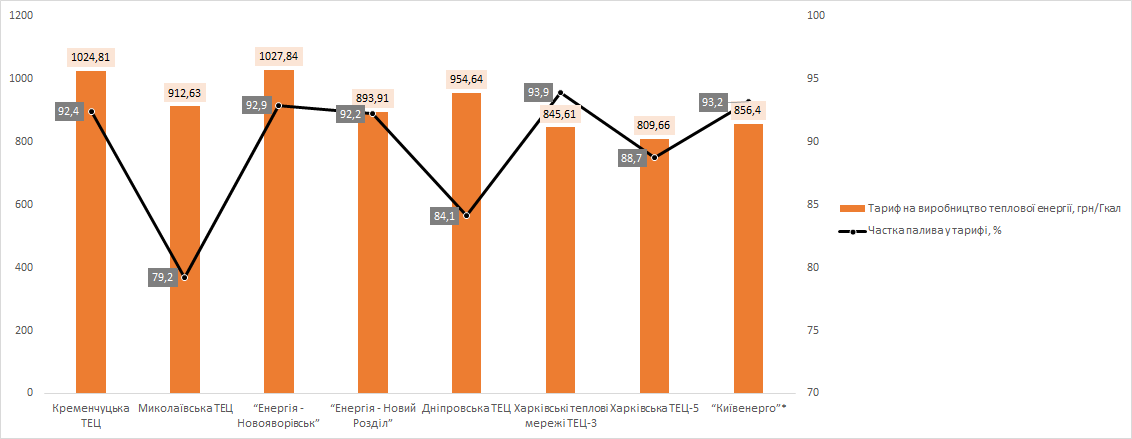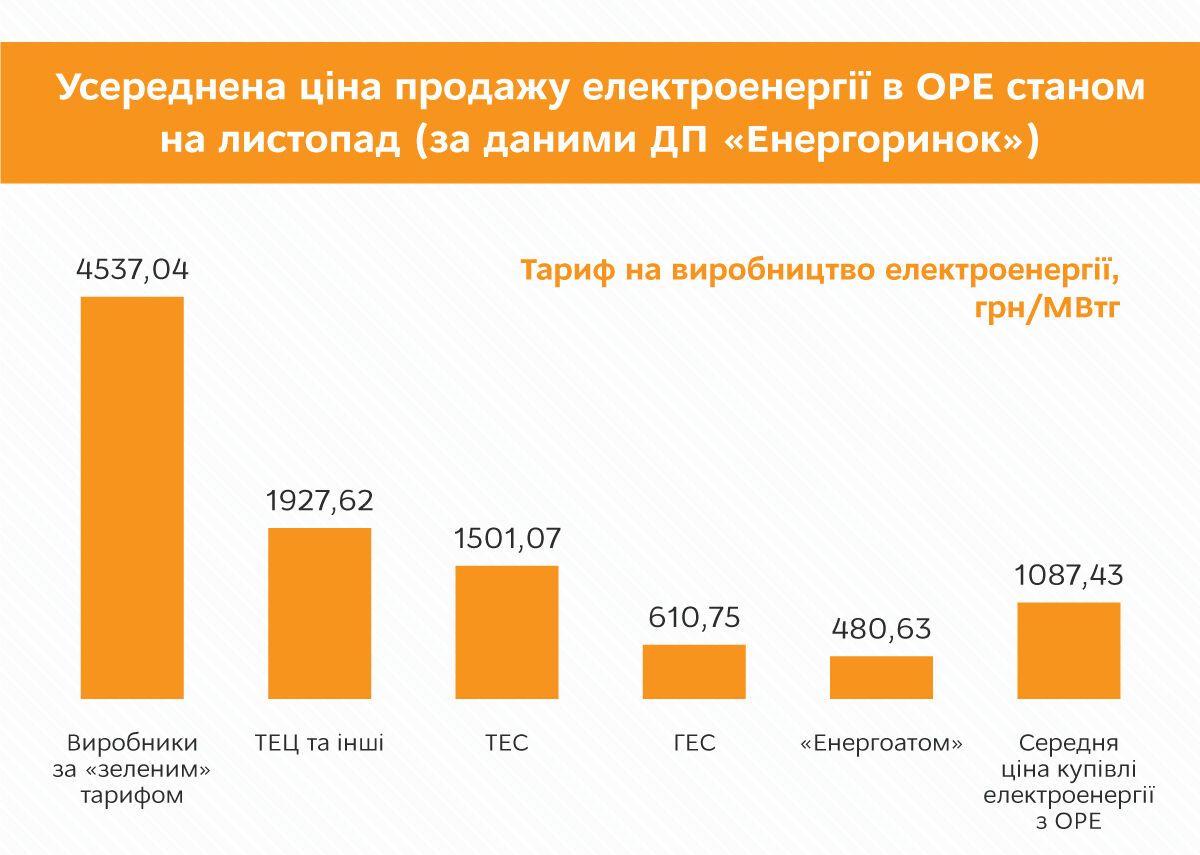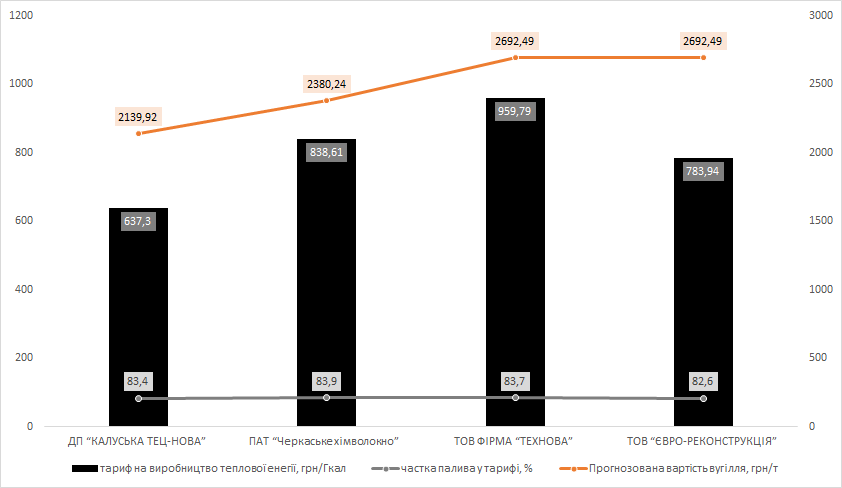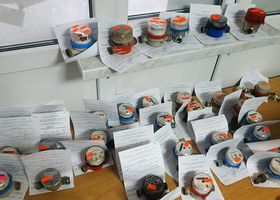Heat tariffs in Ukraine: how to pay less
The 2017-2018 heating season is at its height – and Ukrainian consumers are worried about two issues again: the cost and quality of heat supply. The continuity and properly regulated temperature of the heat-carrier, which ensures a comfortable stay in the heated premises, may be referred to the quality of heating.
Therefore, the amount in the bill for heating mostly depends on the efficiency of its consumption. Simply put, on how much the house loses heat. Combined with the heat metering and control, the reduction of heat loss helps reduce the cost of heating. The second important factor is the losses in electrical grids, which are included in the tariff. Why is it beneficial for central heating and power plants (CHPP) to increase production costs, why does Energoatom subsidize expensive energy produced by CHPPs and how does this ultimately influences tariffs, the analyst Oleksandr Horlushko writes.
The main thing that makes up the tariff for heat is the cost of its production, and an important component of production is the cost of fuel. The percentage of fuel cost in the tariff is 80-95%.
Heat for the needs of district heating can be produced at nuclear power plants (NPPs), thermal power plants (TPPs), central heating and power plants (CHPPs), central heating plants (boiler houses) and enterprises where heat is an accompanying product of the production process (for example, a coking plant).
If you are lucky and there is NPP, TPP or a corresponding enterprise near you, you can be connected to a plant or enterprise and spend on heating significantly less than the average cost of heating in the region. For example, the tariff for the production of heat at TPP is two to three times lower than the heat produced at boiler houses and CHPPs.
This is due to saving on the fuel component, because in the tariff for heat, a consumer pays the cost of heat energy transportation and supply. As for the cost of production – this is the cost of servicing the extraction of excess heat potential from the production process of an enterprise.
CHPP generates heat and electricity on the principle of combined generation, i.e. cogeneration. Cogeneration is a method of increasing fuel efficiency. In this case, the steam generated in boilers runs in turbines for electricity generation. The energy of steam on the secondary circuit goes to heating; the electricity is released into an interconnected electrical system. Both heat and electric energy can be the base energy of CHPP.
The work of CHPP based on the principle of cogeneration aims to increase the efficiency of fuel use by 30-40% – in comparison with heat generation alone. A strategically important product of CHPP work as a critical infrastructure facility is heat energy, which provides heating for buildings during the cold season.
While the electricity can be sold by an enterprise of Ukraine in the wholesale electricity market (WEM), the heat energy is consumed only by the connected network and only in accordance with the schedule of the heat load, which depends on weather conditions.
Therefore, for the efficient use of fuels and reduction of greenhouse gas emissions, it is expedient to determine the base heat energy in volumes corresponding to the actual heat load schedule. That is, it is necessary to produce heat as much as it can be sold. And the electricity produced as an accompanying product can always be sold in the WEM.
European Experience of Combined Generation
In 2004, the European Parliament adopted Directive 2004/8/EC. The objective of the Directive is to encourage the creation of cogeneration stations in the countries of the European Union and to stimulate already existing ones. Possible incentives include investment aid, exemptions from tax or providing tax benefits, “green certificates”, and direct price support schemes.
At present, 11% of electricity in the European Union is produced by combined plants. The saving is about 35 million tons of conventional fuel per year.
The cogeneration develops in Denmark, the Netherlands and Finland in the most active way. By 2020, Germany has set the goal of doubling the production of electricity by CHPPs from 12.5% to 25%. Belgium has introduced the “green certificates” scheme, as well as quotas for cogeneration.
Cogeneration in Ukraine
The Energy Strategy of Ukraine till 2030 determines one of the priority directions of the development of switching the boiler houses producing exclusively heat to the process of cogeneration. For this purpose, the Law of Ukraine On Combined Production of Heat and Electric Energy (Cogeneration) and Utilization of Waste Energy Potential provides for the benefits for cogeneration producers.
Formation of the CHPP Tariff for Electricity
The tariff is formed on the “costs plus” basis. As a result, the fuel costs, direct production costs and investment component are divided by the amount of products produced and rate of return up to 2% of profitability is added.
Let’s consider the situation when CHPP works on coal. The fuel cost, which is included in the tariff, is calculated according to the “Rotterdam +” formula (approved by the NEPURC Resolution of 01.08.2017 No. 991). This is the average price of futures contracts for coal for the next 6 months, according to the European Energy Exchange, adjusted by quality, i.e. the content of sulfur and ash, with the addition of transportation costs. If an enterprise can buy coal at a lower price, then theoretically, the difference will be credited as the profit of the enterprise. The NEPURC recommends channeling the additional profit to the investment needs of an enterprise.
If CHPP works on natural gas, then the cost of fuel shall be approved by the CMU and NEPURC. For the needs of electricity production, the projected gas price is UAH 7,907.20/tcm.
The percentage of fuel cost in the structure of the tariff for 2018 for the electricity output of the largest CHPPs.

The share of the fuel cost in the structure of the tariff for the electricity output of CHPPs operating on coal is approximately 80-85%. On natural gas – 80-90%. As a result, the electricity produced at CHPP is the second in the value after the producers operating according to the “green tariff”.

Now let’s consider the work of CHPPs in the aspect of electricity generation.
First, even after rising tariffs for electricity for consumers, production costs are still not covered by the sale price. In fact, CHPP electricity generation is subsidized by the state Energoatom through the mechanism of the wholesale market price of electricity, when the cost of a lower price of electricity of Energoatom “mixes” with the high price of CHPPs. After that, we obtain the average price, at which electricity is sold, and the funds received are redistributed in accordance with the approved tariffs in favor of CHPPs.
It is fair to note that Energoatom, in addition to CHPP, also “subsidizes” TPPs and renewable energy sources (RES). Thus, TPPs have a large, strategically important share of the balancing maneuvering capacities, and without the generation from TPPs, the power system cannot work at present. Which is very skillfully used by non-state TPPs. As for RES, this is the national “green” energy development strategy, investment in future clean energy sources.
Unlike CHPP, the tariff of which covers practically only expenses with the addition of an investment component and profit up to 2% profitability, RES, by its tariff, covers capital investments in the construction of plants.
Direct costs of RES plants are low and reduced practically to depreciation of equipment. After the return of invested funds in the future, it will be one of the cheapest energies, unlike CHPPs, which will have to spend expensive fossil fuels throughout the lifetime of the plant.
Formation of CHPP Tariff for Heat
At present, boiler houses and CHPPs are still the main suppliers of heat in cities. The share of the heat generated at CHPP-5 and CHPP-6 of Kyivenergo, Kyiv’s largest heat producer, is 48.9%, while boiler houses produce 51.1% of the company’s thermal energy. The town of Kalush is supplied with heat from the Kalush CHPP by almost 60%.
The heat tariff is calculated by the enterprise and submitted for approval by the NEPURC.
Fuel component in the structure of the tariff for CHPP heat production on coal

The estimated cost of gas shall be approved for the needs of different categories of consumers separately by the CMU and NEPURC resolutions – based on the import parity of gas and the coefficient for its transportation.

Where is the Cogeneration?
As noted earlier, the main part of the tariff is the cost of fuel. For the production of one gigacalorie of heat of a boiler-house, it is necessary to spend about 150-160 kg of conditional fuel. Almost the same rate of fuel consumption is given in the calculation of the tariff for heat produced by CHPP.
In 2018, the costs of conditional fuel for the production of heat by CHPP were approved: from the smallest – 139 kg of conditional fuel per gigacalorie (kg c.f./Gcal) (PJSC Mykolayivska CHPP) and to the largest one – 223.3 kg c.f. / Gkal (PJSC DTEK Donetskoblenergo PE Myronivska TPP). Pay attention to the difference.
The question is how the total cost of fuel is distributed between heat generation and electricity generation and where the economic effect of cogeneration is taken into account?
Calculation of costs for heat energy production is regulated by the NEPURC Resolution No. 991. It regulates the heat and electricity production by CHPP, as well as defines them as separate activities and prohibits the subsidization of one activity at the expense of another.
This provision has a positive effect and makes it impossible to overcome the losses of one kind of activity at the expense of the profit of another.
On the other hand, we have two types of activities that are not financially related to each other. In conjunction with a fairly high tariff for the electricity produced at CHPP, it motivates operators to focus on the mode of electricity generation regardless of the required volumes of heat generation. In this case, the principle of cogeneration is lost.
According to the annexes to the calculation of the tariff for heat and electricity of CHPPs, which were published by the NEPURC, the most predicted planned growth of electricity production, compared to the average weighted index for 5 years, is at the state-owned enterprise KALUSH CHPP-NOVA – from the weighted average of 241 to 419 million kWh. With the estimated plan for 2017 being 336 million kWh.
The projected plan for heat energy production at the Kalush CHPP has also increased by 5 times - from the weighted average index 117 for the last 5 years to the forecasted 584 thousand Gcal for 2018. This is due to the launch of a related company – Karpatnaftokhim, which uses the steam produced at CHPP in production.
On the basis of the NEPURC annexes, it is possible to analyze the ratio of heat energy production and electricity generation.
For one gigacalorie of produced heat, it is planned to produce: 396 MWh – at Kyivenergo, 663 MWh – at EURO-RECONSTRUCTION LLC, 688 MWh – at PJSC Kharkivska TPP-5, 365 MWh – PJSC POLTAVAOBLENERGO (Kremenchuk CHPP).
In addition, there are central heat and power plants that produce significantly less electricity. It can be caused by the lack of investment funds and, consequently, the outdated equipment that does not meet the current production requirements.
Enterprises that plan to produce more electricity in relation to planned volumes of heat energy: Kalush CHPP has the cogeneration of 918 MWh per gigacalorie of heat energy, PJSC Cherkaske Khimvolokno (Cherkasy CHPP) – 949 MWh per Gkal., TEHNOVA FIRM LLC (Chernihiv CHPP) – 1,760 MWh per Gkal, LLC Energia – Novyi Rozdil – 1,336 MWh per Gkal.
Two enterprises, which approved the tariff for electricity under the procedure of central heat and power plants, operate in the mode of power plants. At LLC DV NAFTOGAZOVYDOBUVNA KOMPANIYA, 12,884 MWh of electricity account for one produced GCal of heat, at PJSC DTEK Donetskoblenergo PE Myronivska TPP – 9,156 MWh.
In the winter, the heat produced by CHPP is mainly used for heating. In the summer, heat is used in the housing and communal services for hot water heating. In the summer, large industrial enterprises, which border CHPP, use steam in the technological processes of production.
The annex shows projected volumes of electricity output by CHPPs and cogeneration plants for 2018, approved by the Ministry of Energy and Coal Industry. Electricity generation by seasons is as follows. In the summer, small CHPPs do not produce electricity at all. CHPPs providing hot water supply in cities simultaneously reduce the production of electricity by about four times. At the same time, Kalush CHPP will reduce the electricity output by about 30% in the summer (compared with winter). But there are two CHPPs, for which the Ministry of Energy and Coal Industry has approved a practically equal schedule of electricity production: the summer “fluctuations” make up only 20% of winter production at LLC Energia – Novyi Rozdil and LLC SPE Energia – Novoyavorivsk.
Let’s recall that in accordance with the register of court decisions, the NABU detectives were granted the access to documents related to the case of suspicion in the improper use of gas by LLC Energia – Novyi Rozdil. It refers to misuse of gas: it was purchased at a preferential price for the intended purpose – for the heating needs of the population. That is, the gas for the needs of heat generation was used for the production of electricity and its sale in the WEM.
In 2018, gas is planned to be sold for certain categories of consumers at preferential prices. Gas price in calculations of tariffs for heating and hot water supply for the population – UAH 4,942/ tcm, heating and hot water supply of religious organizations – UAH 2,471/tcm, for all others, in particular, for the electricity production – UAH 7,907.20/tcm. The difference in the cost of gas for the needs of heat production for the population and the cost of generating electricity reaches almost UAH 2,965.20. Thus, the scheme of improper use of gas can work again.
Summary
The systemic problem in the formation of tariffs for the production of heat and electric power by CHPPs is the lost principle of cogeneration in the formation of tariffs. The tariff-setting on the “cost plus” principle for each type of activity of CHPP makes it economically feasible to maximize the cost of production. The greater the cost of production, the greater the cash flow of the enterprise.
The development of the production base of enterprises is entirely dependent on investment programs, and the profit of the enterprise (at best) is a percentage of the total cost. Now the profitability is up to 2%.
The NEPURC reports show that approved investment programs are not fully implemented by licensees.
It is appropriate to divide the costs by types of activity. On the one hand, it gave the opportunity to control costs separately for each type of activity and to prohibit cross-subsidization. However, on the other hand, the main objective – to use fossil fuels more efficiently through cogeneration – was lost at the same time.
As a result, now, at the expense of Energoatom, expensive electricity produced at CHPPs is subsidized. It does not have any economic effect either for electricity consumers or for heat consumers. Fuel costs are equal to the costs at boiler houses without cogeneration. The electricity tariff for the CHPP electricity is higher than the TPP tariff.
It is difficult to say how to take into account the principle of cogeneration in tariff setting.
Heat supply companies that have a monopoly in a certain area and are especially important for the infrastructure and life support of these territories are not interested in optimizing costs, in particular for fuel.
Market relations and cessation of subsidies can change the situation. But this is a distant prospect. Moreover, the survival of many enterprises in market conditions without subsidies is questionable.
The investigation was conducted within the framework of the USAID Transparent Energy project. The author’s position may not coincide with the position of the United States Agency for International Development and DiXi Group Think Tank.
Source: Obozrevatel








